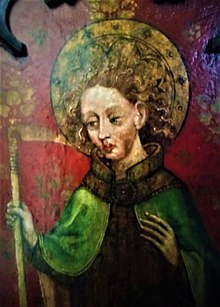Walston | |
|---|---|
 The saint depicted on part of a mediaeval rood screen at St Mary Magdalene, Norwich | |
| Farmer | |
| Born | c. 975? Bawburgh, Norfolk (or Blythburgh, Suffolk) |
| Died | c. 1016 Taverham, Norfolk |
| Venerated in | Anglican Communion Eastern Orthodox Church[1] |
| Canonized | Pre-Congregation |
| Major shrine | previously at Bawburgh |
| Feast | 30 May |
| Patronage | Farms, farm workers |
Walston (recorded as Walstan in some sources) was an Anglo-Saxon prince, known for the miracles which occurred during and after his life after he became a farm worker. He is a patron saint of farm animals and agricultural workers, who once visited his shrine at the church at Bawburgh, in the English county of Norfolk. Two sources for his life exist: the De Sancto Walstano Confessore in the Nova Legenda Angliæ, printed by Wynkyn de Worde in 1516, and known as the English Life; and a later Latin manuscript copied in 1658 from a now lost medieval triptych, now in the Lambeth Palace library in London.
Walstan is associated with Norfolk, but the Latin Life gives his birthplace as Blythburgh in Suffolk and not Bawburgh, as stated in the English Life. Described as the son of Benedict and Blida, he is said to have "received a pious education". At the age of 12 he determined to devote his life to one of prayer, and became a farm worker for a man at Taverham, near Norwich. After being told of his forthcoming death, he made his confession, stopped working and instructed that his two bulls were to pull his body in a cart wherever God willed. After his death on 30 May 1016, his hearse left Taverham and passed through Costessey before reaching Bawburgh, where he was buried; along the route springs miraculously appeared. A small chapel dedicated to Walstan was built at Bawburgh.
He is represented by a crown and sceptre with a scythe in his hand and cattle near him. St Walstan's Day is still celebrated each year in Bawburgh, when a special service takes place on the nearest Sunday to 30 May, his day in the calendar of saints.
- ^ Hutchison-Hall 2014, p. 147.
